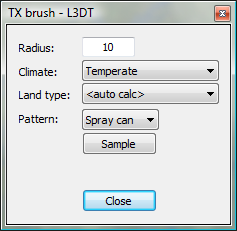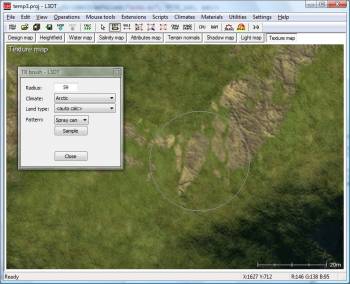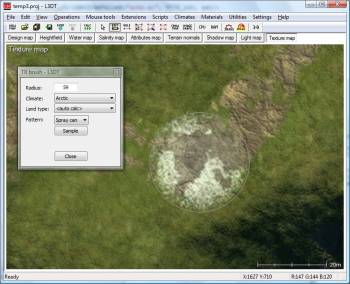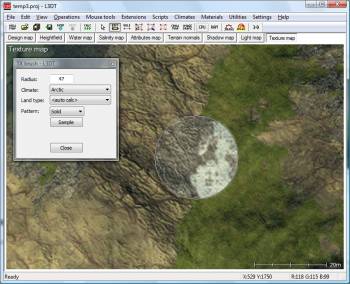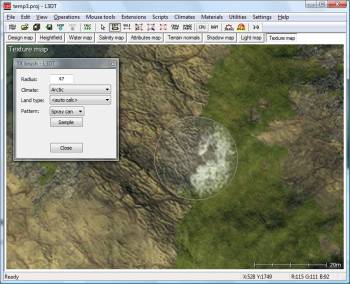|
Table of Contents
Texture map brushThe 'texture map brush' window is activated by selecting the 'Tools→Texture map brush' option in the menu or by viewing the texture map, and then clicking on the 'edit active map layer' toolbar icon, shown below:
Left-clicking and dragging the mouse around on the attributes map will apply the setting from this window. 2D or 3D?Both! The texture map brush may be used in either Sapphire's 3D map view, or in L3DT's 2D map view. To edit the texture map in the 3D editor, select the 'Operations→Texture map→Edit in 3D' menu option in L3DT, or the 'Edit→Texture map brush' menu option in Sapphire. For tips on using the texture map brush in 3D, please refer to the Sapphire user guide. ControlsThe controls in the texture map brush window are explained below: RadiusThe radius field controls the size of the brush tool. Note you can also change the brush radius by using the mouse scroll-wheel in the map window. Climate / Land typeThe climate and land type drop-lists allow you to select the land type that will be applied from the brush. The '<auto calc>' land typeIf you select the '<auto calc>' option in the land type drop-list, L3DT will automatically calculate which land type from your selected climate best suits each pixel in the area you're painting. An example is shown below, where the '<auto calc>' option is used to apply the 'artic' climate over an area of 'temperate' climate. Note how the grass and cliffs in the temperate climate (below left) are automatically replaced by snow and cliffs in the artic climate (below right).
PatternThe pattern drop-list allows you to select between 'solid' and 'spraycan' style brushes, the effects of which are shown below:
Sample buttonThe sample button works a lot like the 'eyedropper' tool in most image editors. If you click on the sample button, then left-click the mouse somewhere in the map window, the climate and land type drop-lists in the will be updated to show the climate/land type from the pixel underneath your mouse click. Updating lighting or bump-maps?At the moment, the texture map brush does not update the normals or light map, as this would make the brush very slow and unresponsive. If you make major changes from, say, snow to rock, you will have to re-generate the normals and light map to update the bump-mapping in the light map. Except where otherwise noted, content on this wiki is licensed under the following license:CC Attribution-Share Alike 3.0 Unported
|


